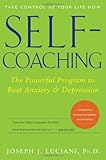Dysthymia
Dysthymia, or dysthymic disorder, is a clinical diagnosis of moderate, persistent depression. Sufferers do not routinely experience the extremes of major depression, but the duration can be much longer. Dysthymia does not often inhibit normal activities.
The depression experienced in dysthymia sufferers tends appear almost as a personality trait. They tend to be self-critical and negative, with low self-esteem. Many dysthymics are unable to recall the last time they felt happy. According to UCSF an estimated 6% of the population will experience dysthymic disorder in their lifetimes.
Symptoms of Dysthymia
- Long-term depression, sadness, anxiety
- Fatigue, difficulty falling asleep or waking and not being able to fall back asleep
- Problems with memory or concentration
- Low self-esteem, guilt, or negative thinking; self-critical
- Depression seems part of one's personality, gloomy, no joy
- Unable to remember last time one was happy, confident, or inspired
- Unexpected weight loss or gain, eating problems
- Symptoms present for over two years
Differences by Gender
Dysthymia in Women
Women are diagnosed with dysthymic disorder at two to three times the rate as men. This increased incidence may be a result of hormonal fluctuation from the menstrual cycle, pregnancy, and menopause. Experts have also suggested that stresses unique to women may be the cause. These stresses include work/home responsibilities, lower wages, single-motherhood, and caring for aging parents. Women in stable marriages have the lowest rates of depression.
Dysthymia in Men
Depressive symptoms often manifest themselves as irritability, anger, and low motivation in men. Men are better able than women to hide their symptoms and are less likely to seek diagnosis and treatment.
Dysthymia by Age Group
Dysthymic disorder is increasingly recognized in children and teens. Girls and boys experience depressive symptoms at equal rates prior to adolescence, at which point the rate increases for girls. Note that for children and teenagers, dysthymic symptoms must be present for one year rather than two.
Dysthymia in the elderly is common, especially after the loss of one's husband or wife or the onset of health problems. The same treatments prescribed for younger people are often effective, however.
Sponsored Links
Books Covering Dysthymic Disorder
-
 Beating the Blues: New Approaches to Overcoming Dysthymia and Chronic Mild Depression
"If you need help lifting the veil of gloom and apathy, this is the best concise guide to treating chronic depression I have seen."
Beating the Blues: New Approaches to Overcoming Dysthymia and Chronic Mild Depression
"If you need help lifting the veil of gloom and apathy, this is the best concise guide to treating chronic depression I have seen."
-
The Mindful Way Through Depression: Freeing Yourself from Chronic Unhappiness (Book & CD) "A thoughtful and scientific combination of Eastern and Western ideas. Helpful to those of us who live in our minds and are susceptible to the never-ending trap of negative thoughts."
-
The Upward Spiral: Using Neuroscience to Reverse the Course of Depression, One Small Change at a Time "Provides a firm scientific foundation for how a person can begin the process of changing the depressed patterns of their brain. The book empowers the individual to take control of their mind."
-
How to Be Happy (Or at Least Less Sad): A Creative Workbook "This book is a great option for anyone who feels in a rut or just wants to do a little soul searching."
-
 For Parents and Teenagers: Dissolving the Barrier Between You and Your Teen
"It is well worth it to be able to reach for this book in times of trouble, when your relationship with your teen or young adult seems to be deteriorating, to open a page at random, and just read."
For Parents and Teenagers: Dissolving the Barrier Between You and Your Teen
"It is well worth it to be able to reach for this book in times of trouble, when your relationship with your teen or young adult seems to be deteriorating, to open a page at random, and just read."
-
 Self-Coaching: The Powerful Program to Beat Anxiety and Depression
"For those who are uncomfortable with the thought of entering therapy or using medication, the self-coaching work here may be just the ticket to greater freedom from depression and anxiety."
Self-Coaching: The Powerful Program to Beat Anxiety and Depression
"For those who are uncomfortable with the thought of entering therapy or using medication, the self-coaching work here may be just the ticket to greater freedom from depression and anxiety."
Dysthymia Resource Links
- Test Your Dysthymia
- Dysthymia - Wikipedia
- MedlinePlus Medical Encyclopedia - Dysthymia
- Dysthymic Disorder - When Depression Lingers
